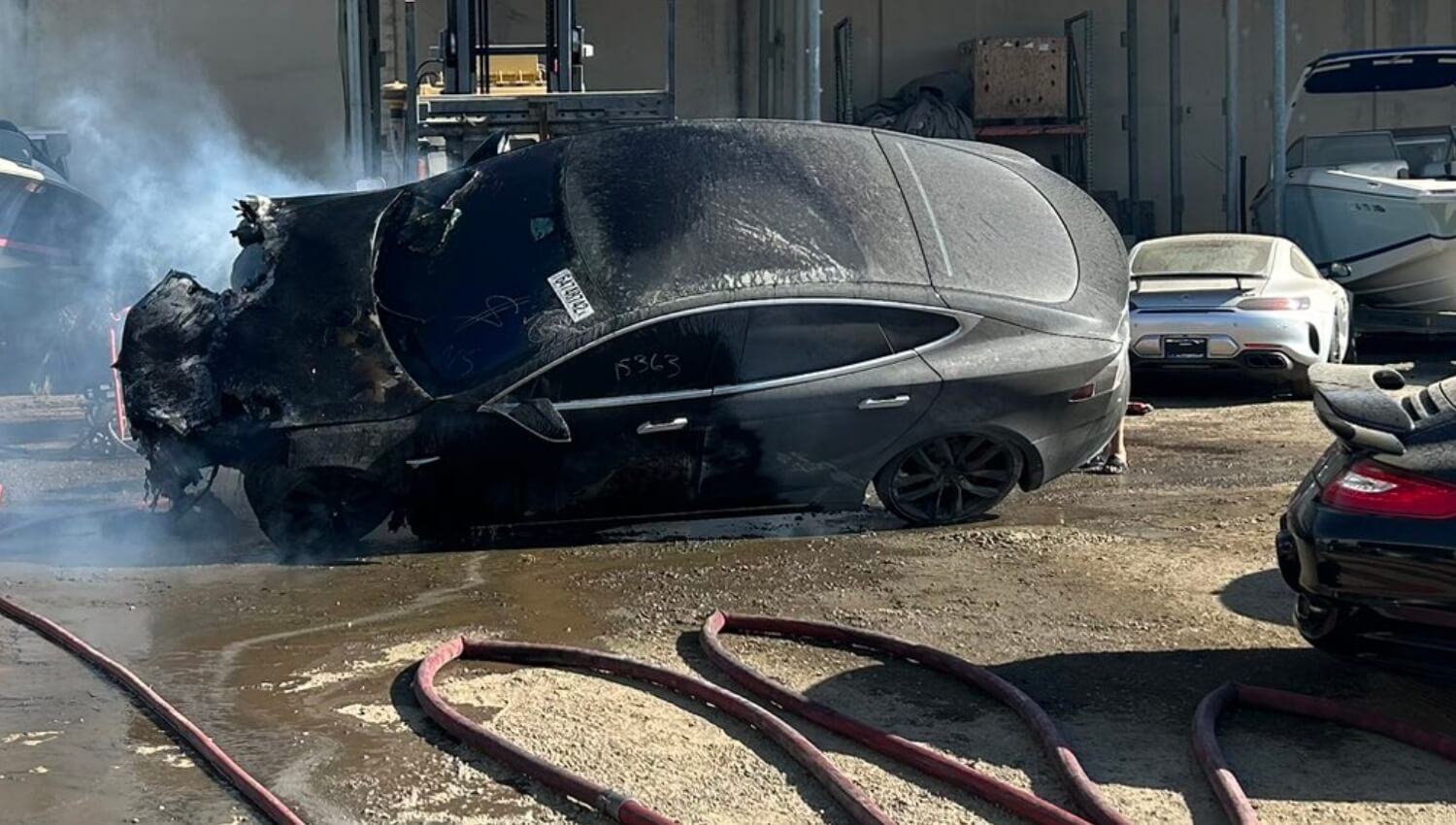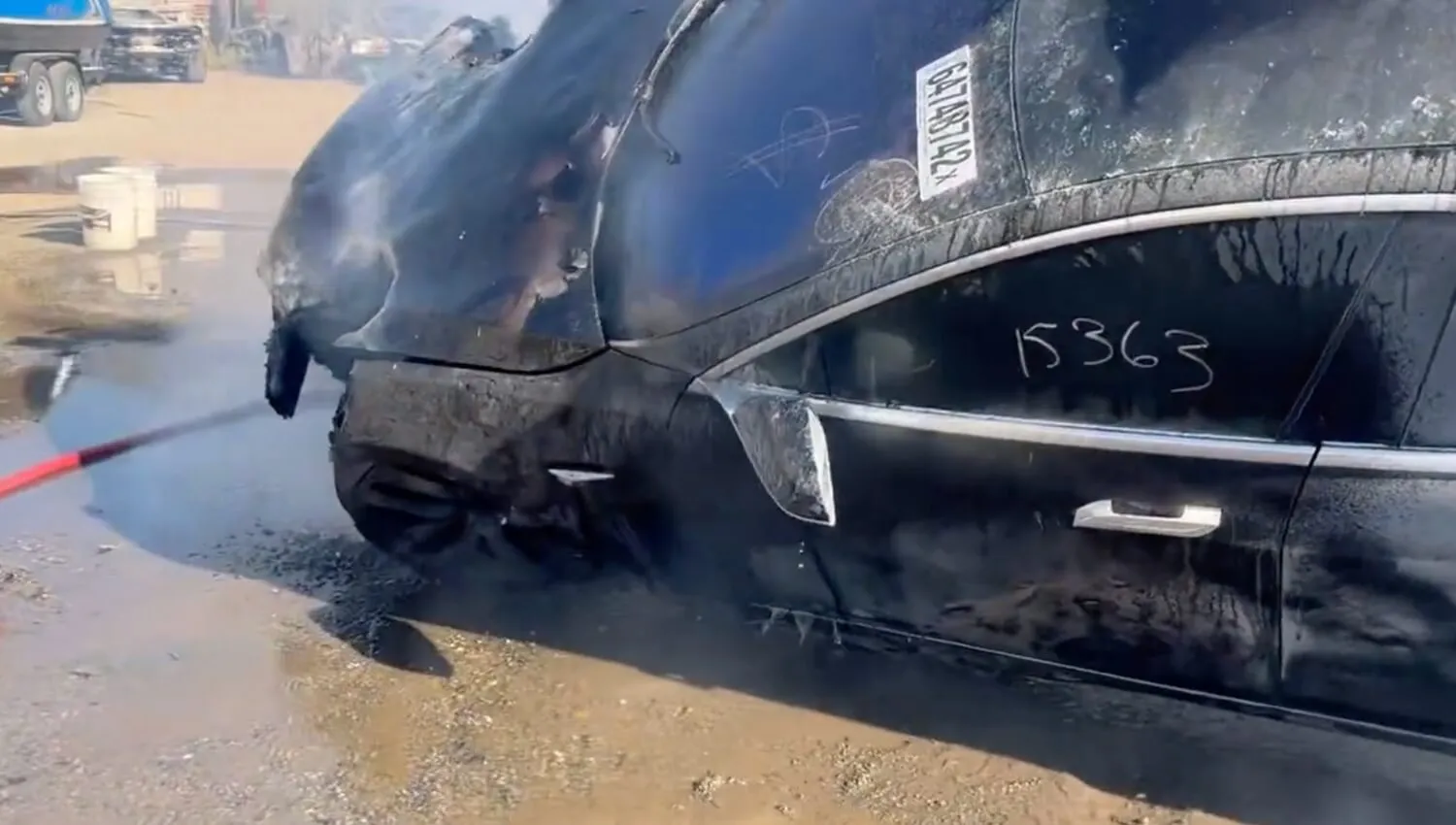In a recent turn of events, Tesla has found itself back in the media spotlight, but unfortunately, not for a positive reason. Reports have emerged of yet another Tesla vehicle catching fire, marking a concerning trend that the company has faced in the past as well. What sets this incident apart is the unusual circumstances under which the fire erupted – the vehicle was not in use for several months.
Tesla has previously dealt with instances of their vehicles catching fire, leading to heightened scrutiny and discussions about the safety of electric vehicles. While electric vehicle fires are not exclusive to Tesla, the company’s high profile and innovative reputation often place it at the center of media attention when such incidents occur.

Table of Contents
Tesla Bursts Into Flames: Incident Details
In California, firefighters rushed to the scene at the incident spot, a luxury auto salvage yard in Rancho Cordova. The electric car, which had been saved from Florida flooding, had been sitting in the yard for a few months when it suddenly caught fire.
Firefighters chose to leave the flaming car in its current place out of safety concerns and because they were unable to move it. Other luxurious automobiles, including Ferraris and Lamborghinis, were also parked all around the Tesla. The fire department posted pictures and footage of the incident on social media, identifying Elon Musk, the owner of both Tesla and the social messaging platform X (formerly known as Twitter).
Elon Musk has not yet commented on the fire department’s social media posts as yet. Tesla has likewise declined to comment on the event.
This is not the first Tesla-related fire that Sacramento firemen had to deal with. Earlier also such incidents have happened. On an earlier occasion, they had to deal with a Tesla Model S’s lithium-ion battery fire on a highway. This event also happened in Rancho Cordova where a Model S caught fire in a junkyard, prompting firefighters to submerge the car in water to put out the flames.
In a statement, Metro Fire Department of Sacramento said:
“Crews responded for a vehicle fire at a high end auto dismantler. The vehicle was involved in an accident several months ago, and was sitting idle when it spontaneously caught fire in the yard. Crews are unable to move it to a safe location to burn out, the vehicle is blocked in and surrounded by millions of dollars in salvaged vehicles including Ferraris, Lamborghinis and Bentleys”
Crews responded for a vehicle fire at a high end auto dismantler. The vehicle was involved in an accident several months ago, and was sitting idle when it spontaneously caught fire in the yard. Crews are unable to move it to a safe location to burn out, the vehicle is blocked in… pic.twitter.com/8ShkbMEQUN
— Metro Fire of Sacramento (@metrofirepio) August 3, 2023
The Science Behind EV Fires
There are thousands of small lithium-ion cells that make up an electric vehicle battery. A single cell may resemble a pouch or cylinder and is made up of an anode, a cathode, and a liquid electrolyte. These chemical elements allow the battery to store energy. The cells are put together to form a battery pack that is covered in an exceptionally durable material, like titanium, and is typically fastened to the undercarriage of the automobile.

Unraveling the Causes of Electric Vehicle Fires
The battery should be nearly impossible to access and, ideally, protected from even the most severe crashes. However, one or more lithium-ion cells may short circuit when an electric vehicle battery is faulty, damaged, or simply fails from the inside. This causes the battery to heat up. Then, the minute membranes dividing the cathode and the anode melt, and hence exposing the highly combustible liquid electrolyte.
Once a fire starts, heat can spread to more cells, causing a phenomenon known as thermal runaway. When this happens, flames spread throughout the battery and start to burn more intensely, starting a fire that could last for several hours.
How EV Fires Differ from Conventional Fires
An EV fire may appear to be rather peaceful in its early stages, with merely smoke coming from the vehicle’s undercarriage. However, once thermal runaway takes hold, blazing orange flames may suddenly consume the entire car. One of these flames can reach temperatures of about 5,000 degrees Fahrenheit due to the enormous amount of stored energy in EV batteries.
Additionally, for an EV whose fire has been blazed off by firefighters, there is a possibility that the car may catch fire several days later. This is because latent heat may still be spreading within the battery cells even after the fire seems to be over.
Also, firefighters have to play a tricky role in extinguishing fires in EVs, since EV flames aren’t ignited by airborne oxygen. Firemen are required to use a tonne of water to cool down the batteries. So as compared to Internal combustion engine vehicles, EVs need a higher quantity of water for extinguishing fire.
Another Fire Engineer Matt Halleck, who works as a training officer in Hillsdale, Michigan states – “As a firefighter, it’s one of our worst nightmares,” he said.
According to Wakefield Fire Provisional Chief Purcell:
“As sales of electric and hybrid vehicles increase, the fire service is continuing to modify our tactics to properly respond, protect property and firefighters as well as control these types of fires,” said Wakefield Fire Provisional Chief Purcell. “Fire companies on the scene of an electrical vehicle fire should expect longer time frames to manage and control EV vehicle fires, ensure that large, continuous, sustainable water supply is established, as well as maintain heightened situational awareness and prepare for secondary fires.”
Safety Precautions for Electric Vehicles
The growing concern over electric vehicle (EV) fires extends beyond the immediate users and impacts a broader spectrum of stakeholders. It’s not just the owners of EVs who are affected; the safety of the areas where these vehicles are parked, including residential spaces, parking lots, and even scrapyards, becomes a pressing issue. The sporadic nature of EV fires and their potential to occur even when the vehicle is stationary raises alarm bells about the risks they pose to both property and public safety.
Manufacturers of electric vehicles play a pivotal role in addressing this concern. As the world shifts towards a more sustainable future with EVs at its forefront, ensuring the safety of these vehicles takes center stage. While the adoption of new technologies is essential for progress, it comes with its own set of challenges that must be addressed promptly and effectively.
The industry’s ability to identify the root causes of EV fires, whether they stem from manufacturing defects, faulty components, or other factors, will determine the overall safety of the EV ecosystem.
Looking Ahead: Ensuring a Safer EV Future
As electric vehicles continue to gain traction as a sustainable and environmentally-friendly transportation option, addressing safety concerns is paramount. The complex composition of EV batteries, with numerous lithium-ion cells working in tandem, demands meticulous engineering and vigilant maintenance to prevent potential hazards. Manufacturers must not only focus on improving battery technology but also on developing robust safety systems that can mitigate risks even when vehicles are stationary.
Firefighters, too, are adapting their approaches to deal with the specific challenges posed by EV fires. The need for substantial water usage to cool down batteries, the possibility of latent heat resurgence, and the potential for delayed ignition all require a shift in firefighting strategies. As the EV landscape evolves and expands, fire departments are integrating new tactics to handle these emerging situations effectively.
While incidents like these are concerning, they also serve as catalysts for innovation and progress. Automakers and researchers are spurred to enhance safety protocols, battery materials, and overall design to ensure a safer and more reliable future for electric vehicles. As the industry endeavors to address and overcome these challenges, the collaboration between automakers, regulatory bodies, and emergency responders will play a crucial role in shaping a secure and successful path forward for the world of electric mobility.


















